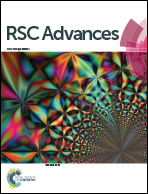Ag-decorated Bi2O3 nanospheres with enhanced visible-light-driven photocatalytic activities for water treatment†
Abstract
Uniform Ag/Bi2O3 nanocomposites with different amounts of Ag were prepared via the deposition precipitation method. Compared with Bi2O3 nanosphere supporters, Ag/Bi2O3 nanocomposites exhibit highly enhanced visible-light-driven Cr(VI) photoreduction activity and photocatalytic bacteria inactivation. Accordingly, the effects that influence the photocatalytic activity of Ag/Bi2O3 nanocomposites were investigated through analyzing its optical properties, photoluminescence, and production of reactive oxygen species (ROS). It was found that the decorated Ag nanoparticles could improve the visible-light adsorption, electron–hole separation efficiency, surface oxygen vacancies and the production of reactive oxygen species of Ag/Bi2O3 nanocomposites, resulting in enhanced photocatalytic performance. This study not only demonstrates that Ag/Bi2O3 could be a promising visible-light-response photocatalyst for water treatment, but it also provides an ideal strategy for improving photocatalytic performance under visible light irradiation.


 Please wait while we load your content...
Please wait while we load your content...